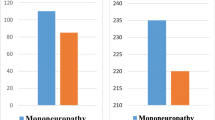Abstract
Total knee arthroplasty performed under spinal or general anesthesia is a common successful orthopedic procedure. Nonetheless, in patients with diabetes mellitus this procedure can present unique challenges to orthopedic surgeon and anesthesiologist alike. We describe a case of an elderly male diabetic patient who developed bilaterally symmetrical lower limb neurological deficit following an uneventful total knee arthroplasty performed under spinal anesthesia. Postoperative nerve conduction study with electromyography confirmed symmetrical extensive denervation of lower limb muscles, including low-voltage fibrillation potentials and positive sharp waves. These findings were consistent with a preexisting neuropathy, thereby suggesting a subclinical neuropathy as a potential risk factor for this neurological complication. Our case highlights the fact that patients with longstanding comorbidities, namely peripheral vascular disease and diabetes mellitus, may be at an increased risk of neurological injury following regional anesthesia. Hence, we believe that preoperative evaluation of diabetic patients should include neurophysiological studies to identify subclinical neuropathy and minimize the risk of neurological injury.
Similar content being viewed by others
References
Yacub JN, Rice JB, Dillingham TR. Nerve injury in patients after hip and knee arthroplasties and knee arthroscopy. Am J Phys Med Rehabil. 2009;88:635–41. (quiz 642–644, 691).
Horlocker TT, Hebl JR, Gali B, Jankowski CJ, Burkle CM, Berry DJ, Zepeda FA, Stevens SR, Schroeder DR. Anesthetic, patient, and surgical risk factors for neurologic complications after prolonged total tourniquet time during total knee arthroplasty. Anesth Analg. 2006;102:950–5.
Blumenthal S, Borgeat A, Maurer K, Beck-Schimmer B, Kliesch U, Marquardt M, Urech J. Preexisting subclinical neuropathy as a risk factor for nerve injury after continuous ropivacaine administration through a femoral nerve catheter. Anesthesiology. 2006;105:1053–6.
Kroin JS, Buvanendran A, Williams DK, Wagenaar B, Moric M, Tuman KJ, Kerns JM. Local anesthetic sciatic nerve block and nerve fiber damage in diabetic rats. Reg Anesth Pain Med. 2010;35:343–50.
Chaudhry V, Cornblath DR. Wallerian degeneration in human nerves: serial electrophysiological studies. Muscle Nerve. 1992;15:687–93.
Gonano C, Leitgeb U, Sitzwohl C, Ihra G, Weinstabl C, Kettner SC. Spinal versus general anesthesia for orthopedic surgery: anesthesia drug and supply costs. Anesth Analg. 2006;102:524–9.
Marchant MH Jr, Viens NA, Cook C, Vail TP, Bolognesi MP. The impact of glycemic control and diabetes mellitus on perioperative outcomes after total joint arthroplasty. J Bone Joint Surg Am. 2009;91:1621–9.
Williams BA, Murinson BB. Diabetes mellitus and subclinical neuropathy: a call for new paths in peripheral nerve block research. Anesthesiology. 2008;109:361–2.
Akbar DH, Mira SA, Zawawi TH, Malibary HM. Subclinical diabetic neuropathy: a common complication in Saudi diabetics. Saudi Med J. 2000;21:433–7.
Bertora P, Valla P, Dezuanni E, Osio M, Mantica D, Bevilacqua M, Norbiato G, Caccia MR, Mangoni A. Prevalence of subclinical neuropathy in diabetic patients: assessment by study of conduction velocity distribution within motor and sensory nerve fibres. J Neurol. 1998;245:81–6.
Hobai IA, Bittner EA, Grecu L. Perioperative spinal cord infarction in nonaortic surgery: report of three cases and review of the literature. J Clin Anesth. 2008;20:307–12.
Pryle BJ, Carter JA, Cadoux-Hudson T. Delayed paraplegia following spinal anaesthesia. Spinal subdural haematoma following dural puncture with a 25 G pencil point needle at T12–L1 in a patient taking aspirin. Anaesthesia. 1996;51:263–5.
Arai M. A posterior horn syndrome presumably due to direct trauma to the sacral cord: a rare complication of epidural anesthesia. Masui (Jpn J Anesthesiol). 1999;48:654–5. (in Japanese with English abstract).
Hebl JR, Kopp SL, Schroeder DR, Horlocker TT. Neurologic complications after neuraxial anesthesia or analgesia in patients with preexisting peripheral sensorimotor neuropathy or diabetic polyneuropathy. Anesth Analg. 2006;103:1294–9.
Eberhart LH, Morin AM, Kranke P, Geldner G, Wulf H. Transient neurologic symptoms after spinal anesthesia. A quantitative systematic overview (meta-analysis) of randomized controlled studies. Anaesthesist. 2002;51:539–46. (in German with English abstract).
Neal JM. Anatomy and pathophysiology of spinal cord injury associated with regional anesthesia and pain medicine. Reg Anesth Pain Med. 2008;33:423–34.
Kalichman MW, Calcutt NA. Local anesthetic-induced conduction block and nerve fiber injury in streptozotocin-diabetic rats. Anesthesiology. 1992;77:941–7.
Williams BA. Toward a potential paradigm shift for the clinical care of diabetic patients requiring perineural analgesia: strategies for using the diabetic rodent model. Reg Anesth Pain Med. 2010;35:329–32.
Author information
Authors and Affiliations
Corresponding author
About this article
Cite this article
Angadi, D.S., Garde, A. Subclinical neuropathy in diabetic patients: a risk factor for bilateral lower limb neurological deficit following spinal anesthesia?. J Anesth 26, 107–110 (2012). https://doi.org/10.1007/s00540-011-1248-7
Received:
Accepted:
Published:
Issue Date:
DOI: https://doi.org/10.1007/s00540-011-1248-7




